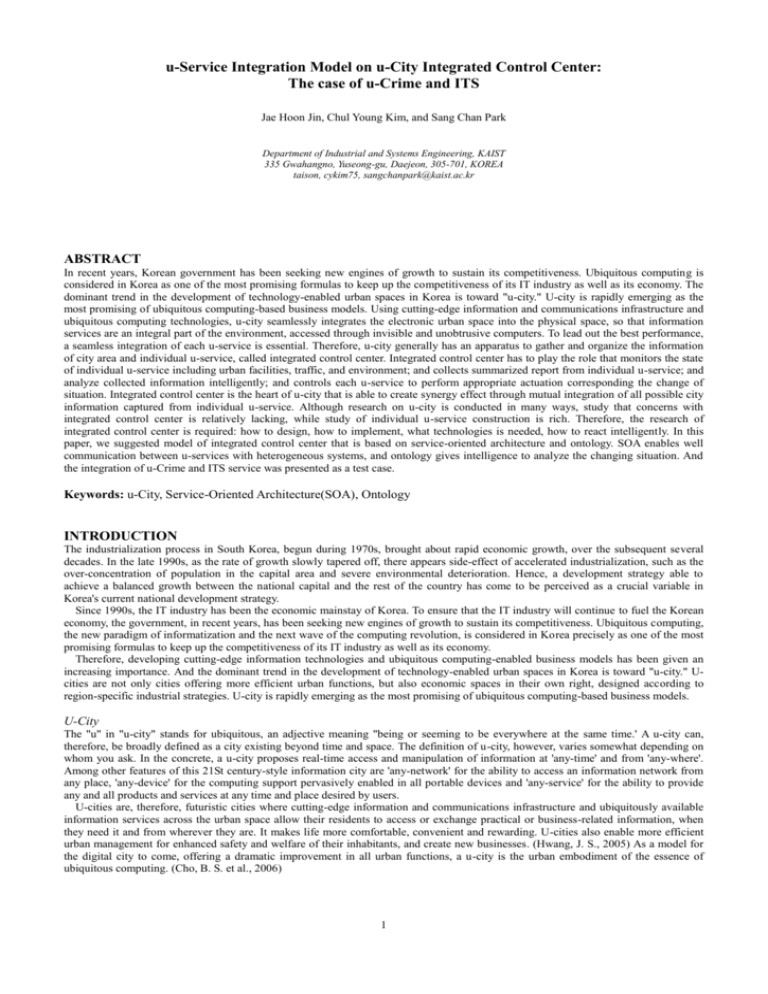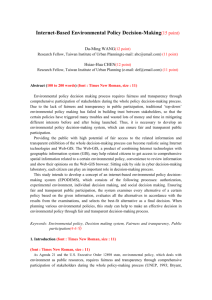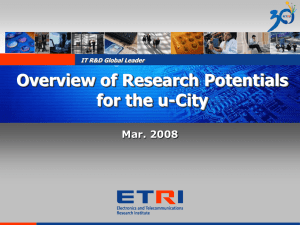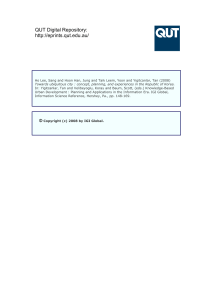u-Service Integration Model on u-City Integrated Control Center:
advertisement

u-Service Integration Model on u-City Integrated Control Center: The case of u-Crime and ITS Jae Hoon Jin, Chul Young Kim, and Sang Chan Park Department of Industrial and Systems Engineering, KAIST 335 Gwahangno, Yuseong-gu, Daejeon, 305-701, KOREA taison, cykim75, sangchanpark@kaist.ac.kr ABSTRACT In recent years, Korean government has been seeking new engines of growth to sustain its competitiveness. Ubiquitous computing is considered in Korea as one of the most promising formulas to keep up the competitiveness of its IT industry as well as its economy. The dominant trend in the development of technology-enabled urban spaces in Korea is toward "u-city." U-city is rapidly emerging as the most promising of ubiquitous computing-based business models. Using cutting-edge information and communications infrastructure and ubiquitous computing technologies, u-city seamlessly integrates the electronic urban space into the physical space, so that information services are an integral part of the environment, accessed through invisible and unobtrusive computers. To lead out the best performance, a seamless integration of each u-service is essential. Therefore, u-city generally has an apparatus to gather and organize the information of city area and individual u-service, called integrated control center. Integrated control center has to play the role that monitors the state of individual u-service including urban facilities, traffic, and environment; and collects summarized report from individual u-service; and analyze collected information intelligently; and controls each u-service to perform appropriate actuation corresponding the change of situation. Integrated control center is the heart of u-city that is able to create synergy effect through mutual integration of all possible city information captured from individual u-service. Although research on u-city is conducted in many ways, study that concerns with integrated control center is relatively lacking, while study of individual u-service construction is rich. Therefore, the research of integrated control center is required: how to design, how to implement, what technologies is needed, how to react intelligently. In this paper, we suggested model of integrated control center that is based on service-oriented architecture and ontology. SOA enables well communication between u-services with heterogeneous systems, and ontology gives intelligence to analyze the changing situation. And the integration of u-Crime and ITS service was presented as a test case. Keywords: u-City, Service-Oriented Architecture(SOA), Ontology INTRODUCTION The industrialization process in South Korea, begun during 1970s, brought about rapid economic growth, over the subsequent several decades. In the late 1990s, as the rate of growth slowly tapered off, there appears side-effect of accelerated industrialization, such as the over-concentration of population in the capital area and severe environmental deterioration. Hence, a development strategy able to achieve a balanced growth between the national capital and the rest of the country has come to be perceived as a crucial variable in Korea's current national development strategy. Since 1990s, the IT industry has been the economic mainstay of Korea. To ensure that the IT industry will continue to fuel the Korean economy, the government, in recent years, has been seeking new engines of growth to sustain its competitiveness. Ubiquitous computing, the new paradigm of informatization and the next wave of the computing revolution, is considered in Korea precisely as one of the most promising formulas to keep up the competitiveness of its IT industry as well as its economy. Therefore, developing cutting-edge information technologies and ubiquitous computing-enabled business models has been given an increasing importance. And the dominant trend in the development of technology-enabled urban spaces in Korea is toward "u-city." Ucities are not only cities offering more efficient urban functions, but also economic spaces in their own right, designed according to region-specific industrial strategies. U-city is rapidly emerging as the most promising of ubiquitous computing-based business models. U-City The "u" in "u-city" stands for ubiquitous, an adjective meaning "being or seeming to be everywhere at the same time.' A u-city can, therefore, be broadly defined as a city existing beyond time and space. The definition of u-city, however, varies somewhat depending on whom you ask. In the concrete, a u-city proposes real-time access and manipulation of information at 'any-time' and from 'any-where'. Among other features of this 21St century-style information city are 'any-network' for the ability to access an information network from any place, 'any-device' for the computing support pervasively enabled in all portable devices and 'any-service' for the ability to provide any and all products and services at any time and place desired by users. U-cities are, therefore, futuristic cities where cutting-edge information and communications infrastructure and ubiquitously available information services across the urban space allow their residents to access or exchange practical or business-related information, when they need it and from wherever they are. It makes life more comfortable, convenient and rewarding. U-cities also enable more efficient urban management for enhanced safety and welfare of their inhabitants, and create new businesses. (Hwang, J. S., 2005) As a model for the digital city to come, offering a dramatic improvement in all urban functions, a u-city is the urban embodiment of the essence of ubiquitous computing. (Cho, B. S. et al., 2006) 1 U-Service As a standard definition is currently lacking as to what u-city services are, services widely vary in name as well as in intended function, depending on the project and who is running it. In spite of these differences, u-city is understood by many as a period or a stage of informatization where a major improvement at the level of network infrastructure, driven notably by broadband infrastructure, makes possible a broad penetration of innovative IT-enabled services, resulting in an explosive growth of both human-to-thing and thing-tothing communications. Research is currently underway to develop services like location-based services, automated product management, automated medical services, disaster prevention services and home services, assisting users with various types of needs and in various circumstances. All of these services can be seamlessly linked, so that they may be accessed across an entire city. (Park, J. H., 2006) Services may be distinguished into basic services that are necessary and common to all urban spaces, and special services designed for certain of them. Services may also be classified, according to their targets, into public services intended to serve the public good, and private-sector services meeting the needs of businesses and consumers. (Kim, E. H., 2006) Integrated Control Center To lead out the best performance of u-city's urban functions and excellent management of u-city, a seamless integration of each u-service is essential. Therefore, u-city generally has an apparatus to gather and organize the information of city area and individual u-service, called integrated control center. Integrated control center has to play the role that monitors the state of individual u-service including urban facilities, traffic, and environment; and collects summarized report from individual u-service; and analyze collected information intelligently; and controls each u-service to perform appropriate actuation corresponding the change of situation. Moreover, Integrated control center is encouraged to provide city portal service which is capable to generate useful information about public service, citizens, and companies; and linking service between urban institutions, such as local government, police department, fire department, hospital. Integrated control center is the heart of u-city that is able to create cinergy effect through mutual integration of all possible city information captured from individual u-service. Other advantages of integrated control center are cost reduction by reusing equipment module and sharing system resource; and increased ability for maintenance and disaster recovery. Although research on u-city is conducted in many ways, study that concerns with integrated control center is relatively lacking, while study of individual u-service construction is rich. Therefore the research of integrated control center is required: how to design, how to implement, what technologies is needed, how to react intelligently. In this paper, we suggested model of integrated control center that is based on service-oriented architecture and ontology. SOA enables well communication between u-services with heterogeneous systems, and ontology gives intelligence to analyze the changing situation. Ontology Ontology is a study of conceptions of reality and the nature of being. It seeks to describe or posit the basic categories and relationships of being or existence to define entities and types of entities within its framework. In both computer science and information science, an ontology is a data model that represents a set of concepts within a domain and the relationships between those concepts. It is used to reason about the objects within that domain. Ontologies are used in artificial intelligence, the Semantic Web, software engineering, biomedical informatics and information architecture as a form of knowledge representation about the world or some part of it. Ontologies generally describe: ▪ ▪ ▪ ▪ ▪ Individuals: the basic or "ground level" objects Classes: sets, collections, or types of objects Attributes: properties, features, characteristics, or parameters that objects can have and share Relations: ways that objects can be related to one another Events: the changing of attributes or relations Ontologies are commonly encoded using ontology languages, such as RDF(Resource Description Framework) and OWL(Web Ontology Language). And SWRL(Semantic Web Rule Language) is used to provide the formal meaning for OWL ontologies including rules written in abstract syntax. Service-Oriented Architecture The emergence of Web services developments and standards in support of automated business integration has driven major technological advances in the integration software space, most notably, the service-oriented architecture. (Booth, D., et al., 2004) The purpose of this architecture is to address the requirements of loosely coupled, standards-based, and protocol-independent distributed computing, mapping enterprise information systems (EIS) appropriately to the overall business process flow. In an SOA, software resources are packaged as “services”, which are well defined, self-contained modules that provide standard business functionality and are independent of the state or context of other services. Services are described in a standard definition language, have a published interface, and communicate with each other requesting execution of their operations in order to collectively support a common business task or process. An SOA is designed to allow developers to overcome many distributed enterprise computing challenges including application integration, transaction management, security policies, while allowing multiple platforms and protocols and leveraging numerous access devices and legacy systems. (Alonso. G., et al., 2004) The driving goal of SOA is to eliminate these barriers so that applications integrate and run seamlessly. In this way an SOA can deliver the flexibility and agility that business users require, defining coarse grained services, which may be aggregated and reused to facilitate ongoing and changing needs of business, as the key building blocks of enterprises. An SOA creates a collection of services that can communicate with each other using service interfaces to pass messages from one service to another, or coordinating an activity between one or more services. 2 Enterprise Service Bus For implementing SOA, a layer of communication and integration logic between the client and server modules is essential. The integration layer must support interoperability among, and coexist with deployed infrastructure and applications. The requirements to provide an appropriately capable and manageable integration infrastructure for Web services and SOA are coalescing into the concept of the Enterprise Service Bus. (Chappell, D., 2004) The ESB exhibits two prominent features. Firstly, it promotes loose coupling of the systems taking part in integration. Secondly, the ESB can break up the integration logic into distinct easily manageable pieces. Conceptually, an ESB provides an implementation backbone for an SOA. It establishes proper control of messaging as well as applies the needs of security, policy, reliability, and accounting, in SOA architecture. The ESB is responsible for the proper control, flow, and translations of all messages between services, using any number of possible messaging protocols. An ESB pulls together applications and discrete integration components to create assemblies of services to form composite business processes, which in turn automate business functions in an enterprise. Framework Thinking the role of integrated control center in u-city, it should have two major features: connectivity between heterogeneous systems and context aware intelligence. We adopted two technologies, ontology and SOA, to solve these problems. SOA and ESB provide mutual connection between heterogeneous individual u-service systems, and ontology gives intelligence reacting properly to the changes of situation. Figure 1 - Overall Framework The overall design of integrated control center is shown in Figure 1. The components of the system include the following. ▪ ▪ ▪ ▪ ▪ ▪ ▪ Enterprise Service Bus (ESB) Global System (Integrated Control Center) Knowledge Base Local Systems (Individual U-Services) Portal User Database Related Institutions The ESB detects messages moving between components and applies translations when appropriate. The global system is the platform on which to host the integrated ontologies and rule base. The knowledge base consists of integrated ontologies, rules and instances. Ontologies were constructed in the OWL and the rules in the SWRL. These were then translated to the knowledge base. The local system, individual u-service, detects events using its sensor and local analysis process, exchanges message over the ESB, and consults the global system and the knowledge base. Events are very various by u-service. The portal does a role to show useful information generated by global system and local systems to citizens and companies. The user database helps context aware inference on global system and personalized service on portal. Related institutions, including security cooperation, police department, fire department, hospital, and so on, receive alert and recommended actions from global system. One of the advantages of this framework is flexibility and extendibility for u-services. If a new u-service is added to overall system, what only to do is revise the ontology and update the knowledge base. Therefore this framework is well-fit with u-city construction that starts from a few u-services and progresses gradually. 3 The case of u-Crime and ITS A crime prevention is "the anticipation, recognition and appraisal of a crime risk and the initiation of some action to remove or reduce it." There are two key elements of a crime: desire and opportunity. Desire is part of human nature and somewhat inherent in us all. Opportunity is the element where we can have the greatest impact. Crime prevention is opportunity reduction. u-Crime Prevention is a service to minimize the opportunity for crime using ubiquitous technology. Moreover, it includes security service to capture criminals. An Intelligent transportation system (ITS) refers to efforts to add information and communications technology to transport infrastructure and vehicles in an effort to manage factors that typically are at odds with each other, such as vehicles, loads, and routes to improve safety and reduce vehicle wear, transportation times, and fuel consumption. (u-ITS simply means ITS in u-City.) Figure 2 - U-Crime and ITS Scenario If a robbery happens, the information from ITS is much valuable to u-Crime Prevention system. The integrated control center can help two systems co-work for arresting the criminals. An example scenario is shown in figure 2. And the overall system works as follows. 1. A thief invades a house. Sensors and CCTV installed in house detect the invasion. 2. U-crime prevention local system processes the sensing data and judges the robbery occurred. 3. Local system sends XML message including situational information based TILE (Time, Identity, Location, and Entity) type to ESB. In example, event occurring time, sensor ID, address, crime type, the house owner information. 4. Global system receives the XML message from ESB. 5. Global system interprets the XML message and queries the context to knowledge base. Knowledge base inferences based on the context and finds appropriate response logic. 6. Global system sends actuation command and alert to proper target. 1.Sends actuation command to local system to track the thief using sensor and CCTV near from event occurred place. 2. Sends actuation command to related local system, u-ITS, to find out a possible fleeing way. 3. Sends alert to related institution, security cooperation and robbery section of police department. 4. Sends current information to house owner. 7. Local systems and related institution works their functions. 1. U-crime prevention system tracks the thief and sends situational information to global system continuously. 2. U-ITS system sends fleeing way information to global system. 3. Security guard and policeman nearest from the thief depart to arrest him. They receive useful information - CCTV image, fleeing way map, and so on - from global system. 8. These actions(3~7) repeat until arrest the criminal. Finally he is arrested. 9. Mission is completed and the information is reported to house owner. This example is typical pattern of u-service works together with other u-services. Integrated control center does core role in these processes. DISCUSSION U-city is rapidly emerging as the most promising of ubiquitous computing-based business models in Korea. And To lead out the best performance of u-city's urban functions and excellent management of u-city, integrated control center is essential. The integrated control center should have two major features: connectivity between heterogeneous systems and context aware intelligence. Ontology and SOA 4 are enough technologies to support these features. SOA and ESB provide mutual connection between heterogeneous individual u-service systems, and ontology gives intelligence reacting properly to the changes of situation. We suggested conceptual model of integrated control center that is based on service-oriented architecture and ontology. And example scenario of u-Crime Prevention co-works with ITS, which shows how u-services are what role integrated and integrated control center does within the whole process, is presented. As u-City grows, many various u-services will be launched and u-city integrated control center will be also expanded to manage uservices. If new u-service fulfills the standard of SOA, adding new ontology, new rules, and new reasoning algorithm is the only required action for the expansion. There is the advantage of our integrated control center model. REFERENCES Hwang, J. S. (2005), "u-City: Basic Strategy And Policy Directions," Tongsinsijang (Telecom Market), No. 59, pp.21-34. Cho, B. S. et al. (Aug. 2006), "u-City: Current Status And Trends," Telecommunications Trend Studies, ETRI, 2006, pp.33-45. Park, J. H. (July-August 2006), "Trends in Core u-City Technologies," Journal of Information Industries. Kim, E. H. (July-August 2006), "u-City Service Deployment Strategy," Journal of Information Industrie. Booth, D., et al. (2004), Web Service Architecture. http://www.w3.org/tr/ws-arch/, W3C, Working Notes. Alonso. G., Casati. F., Kuno. H., Machiraju. V. (2004), Web Services: Concepts, Architectures and Applications, Springer, Heidelberg. Chappell, D. (2004), Enterprise Service Bus, O’Reilly Media, Inc., Sebastopol. 5









